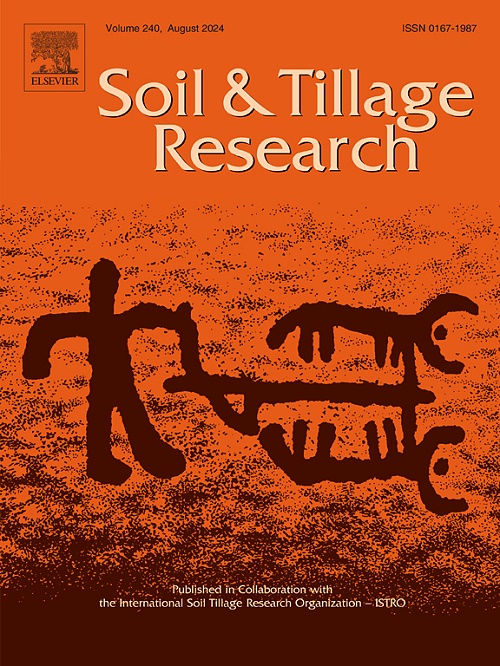滴灌甘薯作物蒸散量模拟[j]。林。用塑料膜覆盖的田地
IF 6.1
1区 农林科学
Q1 SOIL SCIENCE
引用次数: 0
摘要
由于蒸散发是决定作物需水量的主要参数,因此准确估算蒸散发速率对于优化农业用水管理策略至关重要。利用山东省2021-2022年实测的鲍文比能量平衡(BREB)数据,以及相应的气象和土壤数据,对调整后的Shuttleworth-Wallace (SW)模型、调整后的单作物系数模型和双作物系数模型准确估算滴灌甘薯作物ET (ETc)的能力进行了评价。林。用塑料薄膜覆盖的大田作物。BREB方法有效地测量了这些作物生产条件下的ETc,可作为验证其他ETc计算模型可靠性的参考基准。在这些生产条件下,ETc在生长初期较低,在生长中期逐渐升高并保持较高水平,在生长后期开始逐渐降低。甘薯作物生长前期、中期和后期ETc平均占整个生长季蒸散量的比例分别为7.28 %、61.67 %和31.05 %。土壤蒸发量(E)和作物蒸腾量(T)分别占本研究ETc的9 %和91%。调整后的SW模型和调整后的单、双作物系数模型都能准确估计ETc,其中调整后的双作物系数模型比单作物系数模型提供更准确的ETc估计。在当前研究条件下,SW模型最能反映ETc的变化。调整后的sw模型估算的ET (ETc-SW)与使用BREB系统测量的ET (ETc-BREB)之间的R2、MAE、RMSE和IA在2021年分别为0.79、0.29 mm d‑1、0.69 mm d‑1和0.92,在2022年分别为0.77、0.26 mm d‑1、0.67 mm d‑1和0.93。调整后的SW模型可用于地膜滴灌地瓜田土壤E和作物T的估算。本文章由计算机程序翻译,如有差异,请以英文原文为准。
Modeling crop evapotranspiration in a drip-irrigated sweet potato [Ipomoea batatas (L.) Lam.] field with plastic film mulching
As evapotranspiration (ET) is the main parameter determining crop water demand, accurate estimation of evapotranspiration rates is critical for optimizing water management strategies in agriculture. Using Bowen ratio energy balance (BREB) data measured in Shandong Province, China, during 2021–2022, along with corresponding meteorological and soil data, the adjusted Shuttleworth-Wallace (SW) model, along with adjusted single and dual crop coefficient models, were evaluated for their ability to accurately estimate crop ET (ETc) for a drip-irrigated sweet potato [Ipomoea batatas (L.) Lam.] field crop with plastic film mulching. The BREB method effectively measured ETc under these crop production conditions and can thus be regarded as a reference benchmark to verify the reliability of other ETc calculation models. Under these production conditions, ETc was low during the initial growth stage, gradually increased and remained at a high level during the middle growth stage, then began to decrease gradually during the later growth stage. The average proportions of ETc during the sweet potato crop's early, middle, and late growth stages were 7.28 %, 61.67 %, and 31.05 % of the total growing season evapotranspiration, respectively. Soil evaporation (E) and crop transpiration (T) accounted for 9 % and 91%, respectively, of ETc in this study. The adjusted SW model and the adjusted single and double crop coefficient models estimated ETc accurately, with the adjusted dual crop coefficient model providing more accurate ETc estimates than the single crop coefficient model. The SW model best reflected variations in ETc under the present study conditions. The R2, MAE, RMSE, and IA between the adjusted-SW-model-estimated ET (ETc-SW) and the ET measured using the BREB system (ETc-BREB) were 0.79, 0.29 mm d‑1, 0.69 mm d‑1, and 0.92, respectively in 2021, and 0.77, 0.26 mm d‑1, 0.67 mm d‑1, and 0.93 in 2022, respectively. The adjusted SW model can be applied to the estimation of soil E and crop T in drip-irrigated sweet potato field with plastic film mulching.
求助全文
通过发布文献求助,成功后即可免费获取论文全文。
去求助
来源期刊

Soil & Tillage Research
农林科学-土壤科学
CiteScore
13.00
自引率
6.20%
发文量
266
审稿时长
5 months
期刊介绍:
Soil & Tillage Research examines the physical, chemical and biological changes in the soil caused by tillage and field traffic. Manuscripts will be considered on aspects of soil science, physics, technology, mechanization and applied engineering for a sustainable balance among productivity, environmental quality and profitability. The following are examples of suitable topics within the scope of the journal of Soil and Tillage Research:
The agricultural and biosystems engineering associated with tillage (including no-tillage, reduced-tillage and direct drilling), irrigation and drainage, crops and crop rotations, fertilization, rehabilitation of mine spoils and processes used to modify soils. Soil change effects on establishment and yield of crops, growth of plants and roots, structure and erosion of soil, cycling of carbon and nutrients, greenhouse gas emissions, leaching, runoff and other processes that affect environmental quality. Characterization or modeling of tillage and field traffic responses, soil, climate, or topographic effects, soil deformation processes, tillage tools, traction devices, energy requirements, economics, surface and subsurface water quality effects, tillage effects on weed, pest and disease control, and their interactions.
 求助内容:
求助内容: 应助结果提醒方式:
应助结果提醒方式:


